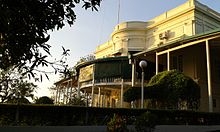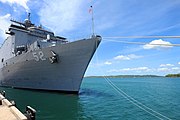SLN Dockyard
| Sri Lanka Navy Dockyard | |
|---|---|
| Trincomalee, Eastern Province in Sri Lanka | |
| Coordinates | 8°33′08.5″N 81°14′16.6″E / 8.552361°N 81.237944°E |
| Type | Naval Base |
| Site information | |
| Owner | Ministry of Defence |
| Controlled by | Sri Lanka Navy |
| Site history | |
| In use | 1948 – present |
Sri Lanka Navy (SLN) Dockyard is the largest
History

Trincomalee is a natural deep-water harbour that has attracted seafarers like
During the colonial expansion into the
The British used Trincomalee has an anchorage for Royal Navy ships in the Indian Ocean. With switch to steam powered ships from the age of sailing, the Royal Navy established a
With the beginning of the 20th century size of the Royal Naval Dockyard of Trincomalee grew as the facilities were increased during and after World War I. A large tank farm was built close to the dockyard store fuel oil of any size fleet, along with dry docks and maintenance facilities to support any ship of the Royal Navy. Due to the increase in personnel on shore and from visiting ships the Royal Naval Hospital Trincomalee was established within the yard.
In 1920, the British began deploying
With the out set of
With
The RAF lost at least eight Hurricanes and the FAA one Fairey Fulmar. The Japanese lost five bombers and six fighters, one in a suicide attack on the Trincomalee fuel tanks. Seven hundred people lost their lives in the attack on Trincomalee. According to eye witness Michael Tomlinson (author of The Most Dangerous Moment and RAF Station Intelligence Officer at Ratmalana and later at China Bay in Trincomalee), one Japanese flyer deliberately crashed his plane into one of the giant fuel tanks just north of China Bay aerodrome.
The Eastern Fleet return to Trincomalee in late 1942. Operation Diplomat, a training exercise, took place in late March 1944. The objective was for the fleet to rendezvous with a group of tankers (escorted by HNLMS Tromp) and practice refuelling at sea procedures. They then rendezvoused with United States Navy Task Force 58.5, comprising USS Saratoga and three destroyers, and returned to Trincomalee on 31 March. The U.S. task force had been detached to the Indian Ocean to bolster local air defences and also to impart necessary procedures to FAA aircrew, which was done over two or three days' intensive activity at sea. Sources for the dates of return to Trincomalee and the joint US/UK training differ. In 1944, a wireless station HMS Highflyer was established in Trincomalee.
The Royal Navy presence in Ceylon came to an end in 1956, when Prime Minister
During
Units
- 3rd Fast Gun Boats Squadron (3 FGS)
- 4th Fast Attack Flotilla (4 FAF)
- 7th Surveillance Command Squadron
Gallery
- SLN Dockyard Trincomalee
-
United States Marine Corps landing craft air cushion onto the Naval and Maritime Academy beach during a theatre security cooperation exchange with the Sri Lanka Navy.
-
US Navy USS Pearl Harbor in SLN Dockyard, Trincomalee.
-
The S-class British submarine HMS Sibyl in harbour at Trincomalee, Ceylon.
See also
References
- ^ Defence Secretary rewards winners of Year Five Scholarship
- ^ Sumana Saparamadu (4 March 2007). "Trincomalee". amazinglanka.com. Retrieved 30 April 2011.
- ISBN 81-7991-199-3.




